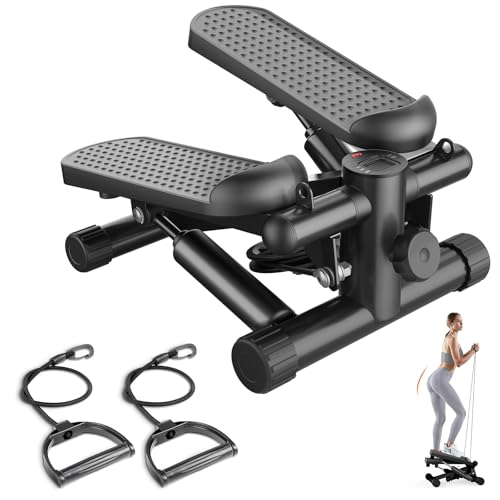The stair climber is a powerhouse tool for slimming down. Find out exactly how effective Is the Stepper Machine Good for Weight Loss? and learn the strategies needed to maximize your calorie burn and muscle engagement.
Yes, the stepper machine is exceptionally effective for weight loss, often ranking among the highest calorie-burning cardiovascular machines available. This intense, low-impact exercise forces the body to work against gravity, creating a significant energy expenditure necessary for achieving a sustainable calorie deficit. The combination of intense cardio and substantial lower-body muscle activation makes the stepper an efficient tool for boosting metabolism and shedding pounds.
The Stepper’s Calorie-Burning Superpower
The primary mechanism by which the stepper machine aids weight loss is through its immense demand for energy. Unlike flat-surface cardio like walking or cycling, the stepper machine constantly simulates vertical movement, forcing the user to lift their entire body weight against gravity with every step.
🛒 Recommended Product
This vertical resistance ensures a highly demanding cardiovascular workout. According to fitness experts, a person weighing 150 pounds can typically burn between 400 and 650 calories per hour on a stepper machine at a moderate intensity. For those engaging in high-intensity interval training (HIIT) or weighing more, this figure can easily exceed 800 calories per hour. Achieving a consistent calorie deficit—burning more calories than you consume—is the fundamental requirement for weight loss, and the stepper machine facilitates this goal rapidly.
Furthermore, the stepper machine is highly efficient because it recruits large, powerful muscle groups simultaneously. When asking Is the Stepper Machine Good for Weight Loss? it is critical to remember that the intensity can be adjusted precisely to fit fitness levels, allowing beginners to ease into the activity while challenging seasoned athletes with maximum speed and resistance.
Muscle Engagement Fuels Long-Term Fat Loss
Weight loss success is not just about calories burned during the workout; it is also about sustained metabolic rate outside of the gym. The stepper machine, also known as a stair climber, excels here by focusing heavily on building and toning the largest muscles in the lower body.
The mechanical action of climbing engages crucial muscle groups, which are the main engines for fat burning:
- Gluteus Maximus and Medius: The primary movers, responsible for powerful hip extension and pushing off the platform. Stronger glutes lead to greater resting calorie expenditure.
- Hamstrings: Activated during the push phase of the step, balancing the force generated by the quads.
- Quadriceps (Quads): Engaged as stabilizers and primary drivers, especially during the descent motion on certain stepper models.
- Calves (Gastrocnemius and Soleus): Work constantly to stabilize the ankles and aid the push-off, contributing to overall stability and strength.
Building muscle through resistance training, which the stepper machine provides by making you lift your own body weight, directly impacts your basal metabolic rate (BMR). Muscle tissue is metabolically active, meaning it burns more calories at rest than fat tissue does. Therefore, regular use of the stepper machine boosts muscle composition, accelerating your metabolism and making it easier to maintain weight loss over time, even on days you aren’t exercising.
Strategic Use: Maximizing Stepper Effectiveness
To truly maximize weight loss results using the stair climber, users should focus on proper technique and incorporating high-intensity methods like HIIT.
🛒 Recommended Product
The HIIT Advantage
Traditional steady-state cardio is effective, but HIIT on the stepper forces the body into an anaerobic state for short bursts, followed by brief recovery periods. This not only burns a high volume of calories during the session but also triggers the “afterburn effect,” or Excess Post-Exercise Oxygen Consumption (EPOC). During EPOC, the body continues to burn calories at an elevated rate for hours following the workout as it recovers and restores oxygen levels.
A sample HIIT stepper workout:
- Warm-up: 5 minutes at a low, steady pace.
- High Intensity: 60 seconds at near-max effort (Level 12–15).
- Active Recovery: 90 seconds at a low, recovery pace (Level 5–7).
- Repeat: Cycle through the High Intensity/Recovery period 8–10 times.
- Cool-down: 5 minutes low intensity stretch.
Form is Key to Efficiency and Safety
Poor form drastically reduces the calorie burn and effectiveness of the stepper. Many users instinctively lean heavily on the handrails, transferring their weight to their arms, which reduces the load on the lower body muscles.
Tips for optimal weight loss form:
- Maintain Upright Posture: Keep your chest up and shoulders back. Only use the handrails for balance, not for supporting your body weight.
- Engage the Core: Keeping your abdominal muscles tight stabilizes the spine and prevents unnecessary sway, ensuring the effort stays in the legs.
- Avoid Flat-Footing: Focus on pushing through the balls of your feet and engaging your heels only briefly. This maximizes glute activation.
- Look Ahead: Avoid looking down at your feet or phone, as this strains the neck and compromises posture.
Stepper Machine Comparison for Weight Loss
The stepper machine consistently outperforms lower-impact machines in terms of calorie expenditure, making it a powerful choice for those prioritizing fast fat loss. Below is a comparison of estimated calorie burns for a 150-pound individual engaging in 60 minutes of moderate-intensity cardio.
| Cardio Machine | Approx. Calories Burned per Hour | Key Weight Loss Advantage |
|---|---|---|
| Stepper Machine (Stair Climber) | 500 – 650 | High Muscle Activation, Intense Vertical Resistance |
| Treadmill (Running) | 600 – 750 | Highest Calorie Burn (but high joint stress) |
| Rowing Machine | 450 – 600 | Full-Body Engagement, Low Impact |
| Elliptical | 300 – 400 | Low Impact, Joint-Friendly, Less Intense Cardio |
The data confirms the stepper machine stands as a middle ground: offering near the calorie-burning capacity of running, but with significantly less impact on the knees and hips, making it accessible for sustained daily use.
🛒 Recommended Product
The Final Verdict
The stepper machine provides a challenging and efficient path to reaching weight loss goals by combining intense cardiovascular stress with powerful lower-body resistance training. If you are asking Is the Stepper Machine Good for Weight Loss?, the data firmly supports its inclusion in any serious fat-loss regimen focused on high calorie expenditure and long-term metabolic improvement.
Scientific References & Research
The following peer-reviewed research papers provide additional scientific context:
-
AJ Bianculli (2009).
Stepper motors: application and selection
[External Link] -
VV Athani (1997).
[B] Stepper motors: fundamentals, applications and design
[External Link] -
M Kukla et al. (2016).
Determination of the torque characteristics of a stepper motor
[External Link]
Note: External research links are provided for educational purposes and do not necessarily represent endorsement.
Frequently Asked Questions About Is the Stepper Machine Good for Weight Loss?
Q. Does the stepper machine specifically target fat storage areas beneficial for weight loss, such as the hips and thighs?
A. Yes, the stepper machine excellently targets the lower body musculature, including the glutes, hamstrings, and quadriceps, which are common areas for fat storage. By building lean muscle mass in these areas, the stepper increases overall metabolic rate, helping the body burn more calories even at rest, thus supporting comprehensive and sustained weight loss. Furthermore, consistent use helps improve body composition by reducing overall body fat percentage.
Q. To maximize weight loss, how often and for what duration should one use the stepper machine weekly?
A. For optimal weight loss results, adults should aim for 150–300 minutes of moderate-intensity activity or 75–150 minutes of vigorous-intensity activity on the stepper machine per week, typically broken down into sessions of 30–60 minutes, 3–5 times weekly. Incorporating interval training (alternating high and low intensity) within these sessions is particularly effective as it boosts calorie burn during the workout and increases metabolic activity afterward. Consistency is key; adhering to a regular schedule is more critical than occasional long sessions.
Q. Is it necessary to combine stepper machine workouts with resistance training to achieve significant weight loss?
A. While the stepper machine alone can create a calorie deficit leading to weight loss, combining it with resistance training is essential for maximizing fat loss and maintaining a healthy body composition. Resistance exercises build and maintain muscle mass, which is metabolically active and prevents the decrease in resting metabolic rate often associated with diet-induced weight loss. Therefore, a balanced routine integrating both cardio and strength training provides the most sustainable path to healthy weight management.
Qt. How does the low-impact nature of the stepper machine benefit individuals starting a weight loss journey, particularly those who are overweight or have joint issues?
A. The stepper machine is generally a low-impact exercise, meaning it puts less stress on the joints (knees, hips, ankles) compared to high-impact activities like running or jogging. This makes it an ideal choice for beginners, individuals with joint pain, or those carrying excess weight, allowing them to engage in vigorous cardio safely and consistently. By minimizing joint strain, the stepper enables longer workout durations necessary for achieving the significant calorie burn required for effective weight loss.
Q. Beyond calorie burn, what other physiological benefits of using the stepper machine contribute to sustainable weight loss success?
A. Regular use of the stepper machine significantly improves cardiovascular health, increasing stamina and endurance, which allows for longer and more intense future workouts, directly contributing to greater calorie expenditure over time. It also improves insulin sensitivity and hormonal balance, aiding the body in regulating blood sugar and reducing fat storage mechanisms, crucial factors for maintaining a healthy weight long-term.
Related Articles
Do Weight Loss Vibration Machines Work?
Vibration machines alone are not magic diet tools Do Weight Loss Vibration Machines Work The consensus from clinical trials suggests they are effectiv…
Do Rowing Machines Help with Weight Loss?
Do Rowing Machines Help with Weight Loss? Rowing machines are an outstanding tool for significant weight loss, uniquely combining high-intensity cardi…
Do Elliptical Machines Work for Weight Loss?
Ellipticals offer a powerful, low-impact solution for achieving aggressive weight management goals. Find out exactly how many calories you can burn an…
When you purchase a product through Amazon links on EllipticalKing.com, we may earn a small commission at no extra cost to you. This helps support the site and keep our content free.




